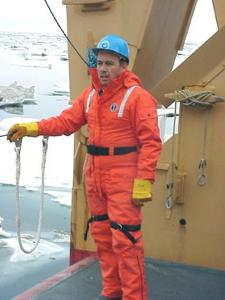
|
|
23 July, 2002
I thought I should let you know why my last few
journals have been posted so late in the afternoon of
the day after the entry. For the past few days, I
have been getting up just in time for lunch after
going to bed very late. Once up, I usually spend time
editing my journal. Although I try to write a draft
before dinner on the day of the journal, things happen
between dinner and when I post the journal, and they
never seem to happen when scheduled. I always check
in at the lab to get an update on times for the
various tests at the station and try to plan my time
based on the posted schedule. Different types of
sampling take different lengths of time. The longest
is perhaps the pumping of water. The group analyzing
water for thorium-234 needs to pump water for fours
hours straight. Everyone else looks forward to the
pumping because they know they have a four hour period
without any other sampling going on and without any
other schedule changes! That’s a long block of time on
board a research ship, and people find lots of ways to
fill it. They do laundry, work out in the ship’s gym,
read, sleep, watch a movie, or use the time to process
their own samples and get caught up with data
recording.
Rick Nelson from the Bedford Institute of Oceanography
in Halifax, Nova Scotia, and Sandor Mulsow from the
International Atomic Energy Marine Radioactivity
Laboratory in Monaco are responsible for doing the
water pumping (and making everyone else very happy for
four hours). Their work is a part of a project being
conducted by Bradley Moran of the University of Rhode
Island. At the designated time, they put four pumps
into the water, each at a different depth. For their
work, it is the top 200 meters of water that are the
most important. The isotope thorium-234 (remember
that an isotope is a different form of an element due
to a different number of neutrons) has a relatively
short half life (a measure of how fast an element will
decay), and it sticks to parcticles in the water. By
measuring the amount of thorium-234, they can get an
indication of “how fast the mill grinds.” Radioactive
elements act as a sort of “clock,” showing us the rate
at which things happen. Rick and Sandor are able to
get a picture of the short term movement of parcticles
(POM or parcticulate organic matter) through the water.
The pumps work very effectively to filter out POM, and
that can actually present somewhat of a problem. The
pumps were designed for work in the ocean basin where,
due to the greater depths, there is far less organic
matter. Because we have been sampling in the Chukchi
Sea which is so productive, the filters collect an
enormous amount of material. It took nearly nine
hours for Rick to complete the final filtering of
approximately 1000 milliliters of water (about a
quart)! Once the filtering is complete, the filter
itself is burned in a 500 degree oven in order to
produce an ash. They then measure the gamma radiation
released by the thorium in the ash. As the gamma
counter works on the sample, a computer records and
graphs the resulting data.
Check out the pictures below to see what the actual
filter looks like. The picture of Sandor also gives
you a much better idea of the mustang suits we all
wear on deck.

Rick Nelson is one of the two men who give us all a break when they need to pump water for four hours. He's standing next to one of the pumps.

Sandor Mulsow is the other man to whom we all give thanks whenever he needs to pump water!

This time conditions were nearly perfect for lowering the pump. When there's too much floating ice, it must be pushed away before any equipment can be deployed.
Contact the TEA in the field at
.
If you cannot connect through your browser, copy the
TEA's e-mail address in the "To:" line of
your favorite e-mail package.
|
